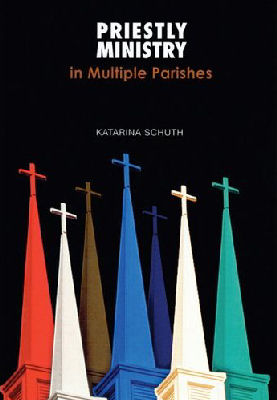
|
Posted March 9, 2007
Book: Priestly Ministry in Multiple Parishes Author: Katarina Schuth Liturgical Press. Collegeville, MN. 2007. Pp. 233 An Excerpt from the Jacket:
An Excerpt from the Book: Personal expectations and communal expectations As the extent of duties grow with responsibility for two or more parishes, pastors are faced with more expectations than they can possibly fulfill. During personal interviews and throughout the survey, one of the clearest cautions for those engaging in this ministry is honesty about what can and cannot reasonably be done. Typical comments represent ths viewpoint: “Clearly state that you can’t do everything, not even all the things you would like to do,” and “learn to balance or accept what simply cannot be done.” An older priest from the Northeast region said, “Do the best at doing what you are able to do and leave the rest to the Lord; we’re not the savior, God is; God is doing something here and it still isn’t completely clear what that is.” Many priests have difficulty knowing exactly what “enough” is, fearing that they may be perceived as disinterested and lazy on one hand, or ambitious and over stretching themselves on the other. It takes time to develop a clear sense of expectations and priorities as well as personal limitations. Depending on the comparative age, energy, and enthusiasm of the previous pastor, it may be necessary for a new pastor to change expectation. One of the most difficult is altering the Mass schedule. When that is necessary, the advice of a pastor in his third assignment in clustered parishes is, “Take in stride the fact that we cannot please everyone and accept the criticism without letting it get you down.” Another adds, “Try and do the best you can in your work; develop realistic expectations and a thick skin. Remember that even Jesus could not please everyone even after three years of working countless miracles.” Another area of concern may involve adding staff or changing their responsibilities. In some cases, if the pastor wishes to add staff, parishioners perceive the action as a shortcoming in the pastor or an indifference to finances. In other instances, asking staff members who have been responsible for assisting in only one parish to cover duties in other parishes in the cluster may be met with stiff resistance. In working with several parishes, pastors recognize how unrealistic demands can be. To maintain a positive attitude, a young priest from the South Central region asserts, “Know that your ministerial reality is foolish and your pastoral expectations unrealistic; do what you can and that’s enough; take care of your hamburger stand and don’t worry about anyone else’s.” With a similar outlook, an older priest from the West says, Don’t compare your schedule to others or let them compare theirs with you. Parishioners need to realize that neither parish will be able to have the same presence of a priest that they are accustomed to. Educate the people as to what they can/should realistically expect from their pastor. Help people grow in a sense of the total community being served. Table of Contents: Part I. Patterns and context of clustered parishes 1. The emerging realities of multiple parishes 2. Patterns of service 3. Nature of parishes Part II. Background and context of priests serving multiple parishes 4. Background, preparation, and continuing education 5. Current personal and ministerial context Part III. Experience of ministry in multiple parishes 6. Current ministerial roles and responsibilities 7. Ministerial responsibilities: assessment of what gives life to parishes 8. Levels of satisfaction with ministerial relationships and responsibilities Part IV. Recommendations for the future of multiple parish ministry 9. Pastoral advice for those newly assigned to multiple parish ministry 10. Suggestions for improving the morale of priests 11. Increasing ministerial effectiveness 12. Recommendations for seminaries 13. Diocesan models for multiple parish ministry 14. Listening and learning |
|
